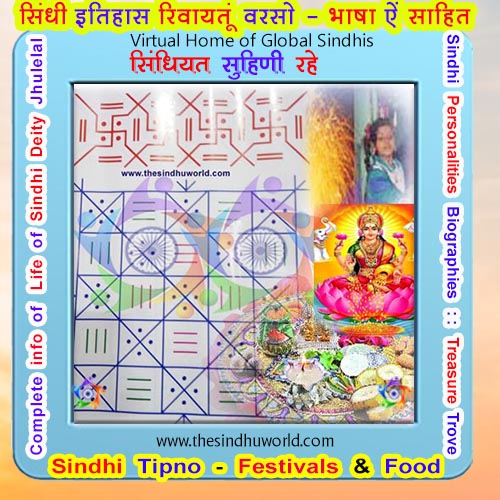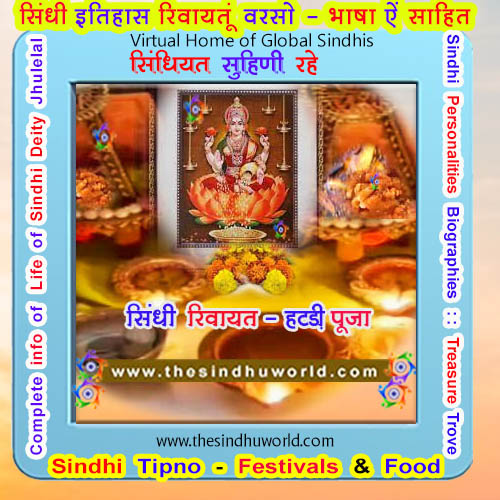Diyari Deepavali
About Deepavali - The Festival of Lights

Sindhi Festival – Biggest Indian Festival – Laxmi Pooja
Rose is the king of flowers, so is the Deepavali – the festival of lights – is the crowning diamond of all the festivals which is celebrated not only by Sindhi, Hindu but by most of Indians and in all parts of world where people of Indian origin have population.
Diyari is celebrated, precisely twenty days following Dussehra, (sometime in October or November) on Amavasya day of Asu month of Sindhi calendar (Tipano). The Usual celebration of Diyari goes for Four days, though at some places celebrations last for five days.
Celebration of this festival starts on the day of Amavasya, a day with no moon in the night sky hence sky seemed to filed with colourful and sparkling lights of fire crackers and thus Deepavali is also referred as the festival of lights. Lamps & mango plant leaves are used to decorate houses.
Deepavali - Celebration Days
The first day of Deepavali is celebrated as “Naraka Chaturdashi” as per the puranas this is the day on which demon Naraka was killed by Satyabhama, wife of Lord Krishna and reincarnation of Bhudevi, mother of Naraka, as per the boon from Brahma, Naraka can face death only at her hands.
Second day is “Laxmi Pooja” (Diyari) Goddess Laxmi is the Goddess of wealth.
The third day is Bal Pirtipada in sindhi Badu [Bhau Bij in Maharashtra].
while “Yama Dwitiya” (Chandu)is the fourth day.
In the sindhi homes Diyari is celebrated only for three days namely Diyari, Badu & Chandu.
Worship Rituals: Sindhi Hatadi Pooja

If we look at the Diwali day worship rituals performed at a Sindhi home almost all are similar and resembling with Hindu worship rituals but still a few things are different. The important difference is at Sindhi homes along with worship of Goddess Laxmi there is ritual of worshiping Hatadi a typical structure made of clay. In the olden day commercial or business pleases of Sindhi community were pronounced as Hat meaning shop in fact word Hatadi is derivation of this word Hat. Thus, we can conclude that Sindhi community have a tradition of worshiping their shops along with Goddess Laxmi on the Diwali day.
In the modern times at some places wooden Hatadi and at most of Sindhi homes small steel plates are used in place of clay and home-made Hatadi. The number of Hatadi at worship place varies from home to home and is directly connected with number of male members of family. In the olden days there was tradition of keeping one more Hatadi in hope of arrival of next male member of family but now-a-days these numbers are equal. On each Hatadi and wall, near which space is decorated for Laxmi Pooja there is special diagram is drawn with the help of Sindoor [Red] and Guli [Blue- a substance used to bring shine in washed cloths] called Butada is drawn.
In the Butada red color is symbol of asking boon for the women of family to remain for entire life with living husband and blue color is for boon of more cleanness. Actually, this Butada is drawn for saving the home from devil spirits and negativity. A green wild fruit called Mitero in Sindhi is kept on each Hatadi as symbol of Greenery and wellbeing.
Before the start of worship small quantity of sweets brought are placed on each Hatadi which is eaten after completing worship. Almost more than half century ago this was custom of Sindhi families that only male members were allowed to performed Hatadi Pooja but now-a-days all the families members are worshiping.
Worship Rituals: Sindhi Traditions & Customs
There is yet another Sindhi tradition associated with Diwali worship which is performed after Hatadi Pooja and before start of burning the crackers. At one end of these small pieces of stem of crop like Maize called Kana are wrapped with cotton at one end to be shaped as Mashal or torch and are taken out of home in burning status. In the Gujarat this trading is named as Taking Malira [derived from word Mashal] and in Maharashtra Taking Kana. This is said that it is performed to memorised the welcome style of citizen of Ayodhya which they have performed for welcoming Shriram who was returning home from Vanvas. As this tradition is not fallowed by all Sindhi families so there is folk lore for it. According to which this is observed in only those Sindhi families who during the Laxmi Pooja on Diwali day have asked for boon of birth of children and promise to do so.
Importance of Diwali
As this festival is celebrated after the rainy season is over hence cleaning and decorating houses have some hygienic importance also. According to Puranas Deepavali is the day of return of Lord Rama to capital Ayodhya after the Vanvas [living in forest] of fourteen years and to welcome the king citizens have decorated the city with the series [Mala] of lamps [Deeps] hence tradition of celebrating Deepavali was started.
